Mridanga Saileswari Temple Tour With A Guide to Keralas Ancient Shrine
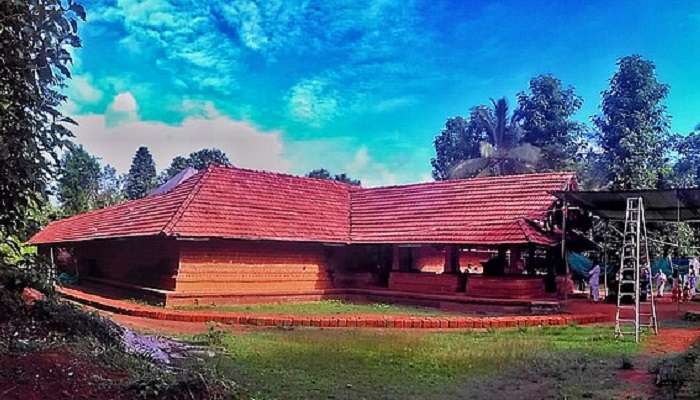
In the heart of Kerala rests a marvel that has endured the passage of time – the Mridanga Saileswari Temple. This ancient shrine, dedicated to the goddess Maa Saileswari, is a testament to the region’s cultural legacy and spiritual importance. The temple’s design, blending Kalinga and Ahom styles, is a sight. Apart from its splendour, the Mridanga Saileswari Temple holds spiritual significance. Whether interested in history, architecture or spirituality, visiting this temple guarantees an experience that will inspire awe and amazement. This piece aims to uncover captivating stories and delve into the timeless charm of this sanctuary.
Mridanga Saileswari Temple: An Overview
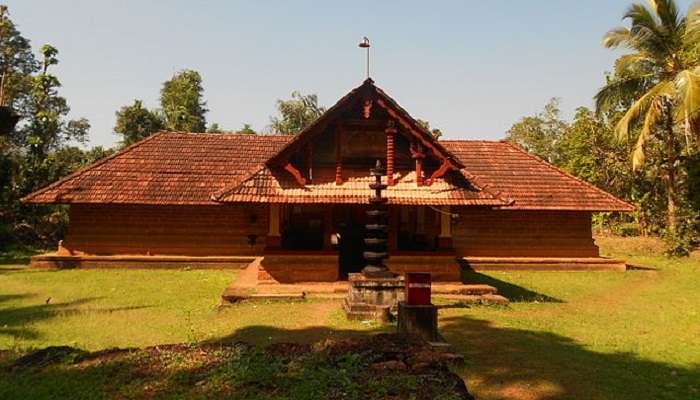
The Mridanga Saileswari Temple is a renowned Hindu temple in Muzhakunnu, Kannur district, Kerala, India. Steeped in legend and history, it holds a significant position among the 108 Durga temples of ancient Kerala. Local tradition attributes the temple’s establishment to Parashurama, the sixth avatar of Lord Vishnu.
The temple’s presiding deity is Mridanga Saileswari, a four-armed manifestation of Goddess Durga. This powerful form is depicted holding a conch and discus in her upper hands, symbolising blessings and divine power. The remaining two hands portray her bestowing grace upon devotees and resting on her waist in a posture of composure. The temple’s rich tapestry extends beyond its religious significance. It is considered the family temple of the Kottayam royal family, further elevating its historical importance. The legendary Pazhassi Raja, a revered figure in Kerala’s history, is also closely associated with this temple.
The Mridanga Saileswari Temple has transcended the boundaries of a place of worship. It is a cultural and historical landmark, attracting pilgrims, history enthusiasts, and those seeking spiritual solace.
Must Read: Kannur To Wayanad Road Trip
Delve Into The History
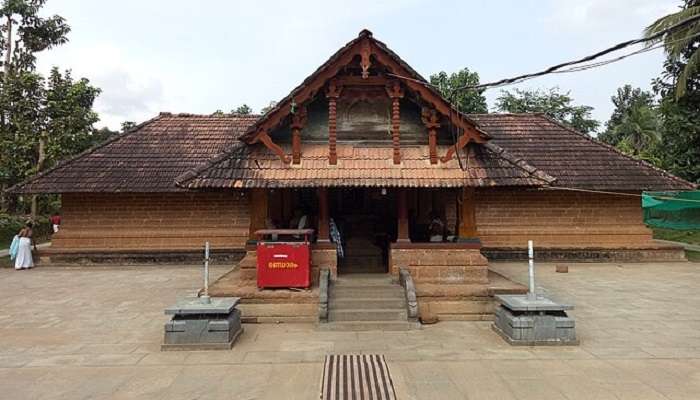
Steeped in myth and legend, the Mridanga Saileswari Temple’s history is intertwined with the region’s culture.
- Legends of Origin
One popular tale attributes the temple’s founding to Sage Parasurama believed to be the incarnation of Lord Vishnu. He supposedly established 108 temples across Kerala, with Mridanga Saileswari being one of them. Another tale offers an explanation for the name “Mridanga Saileswari.” “Mridanga” refers to a percussion instrument, while “Saileswari” translates to “Goddess of the mountain.” Local stories tell of a rock, a meteor shaped like a Mridanga drum, falling from the sky. This extraordinary event is believed to have marked where the Devis’ presence was felt, prompting Sage Parasurama to honour her. - The Abode Of The Divine Musician
The temple’s name suggests its connection to music and the arts. The Mridanga is commonly linked with Hindu deities such as Ganesha and Nandi Lord Shivas Mount. It is believed that the influence of Goddess Saraswati is decisive in this place. This belief is further reinforced by the tradition that visiting this temple without offering prayers to “Mizhavil Bhagavati,” a representation of the Devi in the form of a Mridanga drum enshrined in the sanctum, would be incomplete. - Royal Connections And The Legacy Of Pazhassi Raja
The Mridanga Saileswari Temple is important for Kerala’s Kottayam family as their ancestral deity. The renowned Pazhassi Raja, known for his resistance against rule, has close ties with this temple. Legends have it that Pazhassi Raja created several known Kathakali performances within the temple grounds, reinforcing the temple’s connection to the arts. - From Ruins To National Recognition
The Mridanga Saileswari Temple experienced a period of neglect and deterioration. However, over time, it has regained recognition. Alexander Jacob, a retired police officer from Kerala, unearthed the temple’s history, sparking interest in its preservation and cultural importance. Today, the Mridanga Saileswari Temple stands as an important cultural heritage.
Darshan And Pooja Timings
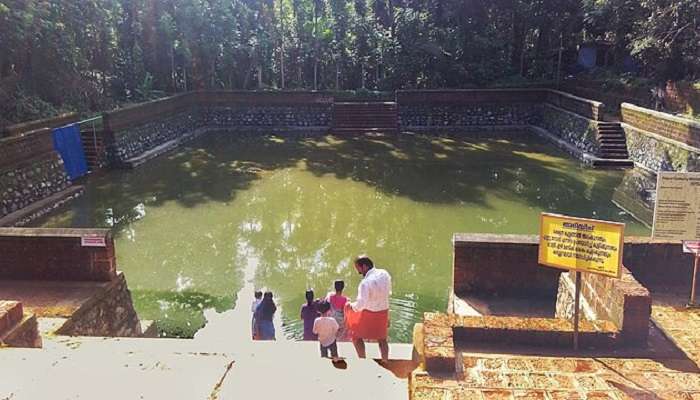
The Mridanga Saileswari Temple welcomes devotees for darshan, or viewing the deity, during two daily time slots. In the mornings, you can visit between 5:00 am and 12:30 pm; in the evenings, the Mridanga Saileswari temple darshan timings are from 5:00 pm to 8:00 pm. Several pujas, or prayer rituals, are conducted throughout the day.
The Usha Pooja (morning prayer) occurs at 7:00 a.m., followed by the Uchha Pooja (noon prayer) at 11:00 a.m. In the evenings, witness the Atthazha Pooja, or evening prayer, at 7:15 p.m. A Deeparadhana ceremony is also performed at sunset, marking the end of the day. Plan your visit accordingly if you want to participate in a specific puja. The temple website even offers online puja services, allowing you to request that a puja be performed on your behalf.
Suggested Read: Resorts Near Kannur
How To Reach
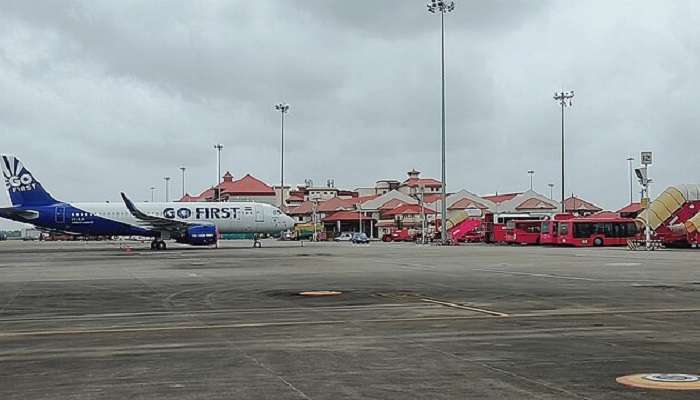
Below is how you can reach Mridanga Saileswari Temple:
By Air
The closest airport to Mridanga Saileswari Temple is Kannur International Airport (Kannur Airport), which is approximately a 45-minute drive from the temple. You can hire a taxi or cab from the airport to reach the temple.
By Train
Thalassery Railway Station (35.8 km) and Kannur Railway Station (44.3 km) are the railway stations to the temple. You can opt for taxi or cab services from these stations to reach the temple.
By Road
The temple enjoys excellent road connectivity to major cities in Kerala. Here are some routes you can take:
- From Thalassery: Take the Koothuparamba – Uruvachal – Thillankeri – Muzhakkunnu Temple road (around 40 km).
- From Taliparamba: Take Irikkur – Iritty – Kakkayangad – Muzhakkunnu Temple road (around 40 km).
- From Kannur: Take Mattannur – Thillankeri – Muzhakkunnu Temple road (around 40 km).
To reach the temple, you can also take a bus from the Koothuparamba, Iritty, or Mattannur bus stand.
Further Read: Hotels In Kannur
The Mridanga Saileswari Temple is a unique and fascinating piece of Kerala’s rich cultural heritage. This temple offers visitors a window into the state’s ancient traditions and spiritual beliefs. Whether you’re a history buff, architecture enthusiast, or seeking a serene escape, the Mridanga Saileswari Temple promises an enriching and memorable experience. Enjoy Kerala’s captivating charm by booking your trip to Kerala today. Explore this vibrant state’s diverse attractions, from historic temples to its breathtaking backwaters, lush hill stations, and mouth-watering culinary delights. Don’t miss the opportunity to create lasting memories in God’s Own Country—plan your Kerala adventure now!
For our editorial codes of conduct and copyright disclaimer, please click here.
Cover Image Source: Vaikoovery for Wikimedia Commons
Frequently Asked Questions About Mridanga Saileswari Temple
What is the story behind the Mridanga Saileswari Temple?
There are two main stories associated with the temple's origin. The first is about the Legend of the Mridanga. This story claims a 'mridanga' (drum) fell from heaven, giving the place its name 'Mridangashaila' (the place where the mridanga fell). Over time, this transformed into Muzhakkunnu, the temple's location. The second one is about the Parashurama connection. This belief suggests the temple is one of 108 Durga temples established in ancient Kerala by Parashurama, the sixth avatar of Vishnu.
What is the dress code for the Mridanga Saileswari Temple?
While there's no strict dress code enforced at the temple, modesty is considered respectful. Devotees typically wear comfortable clothing that covers their shoulders and knees.
What is the time of Mridanga Saileswari Temple Pooja?
The temple conducts several pujas daily at specific times: Usha Pooja (Morning Prayer) at 7:00 AM, Uchha Pooja at 11:00 AM, Atthazha Pooja (Evening Prayer) at 7:15 PM, and Deeparadhana (Aarthi) performed at sunset.
What is famous in Kannur to buy?
Kannur is renowned for its handloom textiles, particularly Kasaragod Sarees and Kannur Khadi, vibrant Theyyam masks used in ritualistic performances, Ayurvedic products based on traditional Indian medicine, and fresh, flavorful cashew nuts and spices from the region.
What is special in Kannur?
Kannur offers a variety of experiences, including exploring its rich history through forts like Fort St. Angelo and museums showcasing Kerala's past, relaxing on beautiful beaches like Payyambalam Beach, indulging in Ayurvedic massages and treatments, witnessing vibrant Theyyam performances, and exploring the roots of Kathakali, a classical dance drama believed to have originated in Muzhakkunnu.
People Also Read:
Pura Taman Kemuda Saraswati Temple Chamundeshwari Temple Jambukeswarar Temple

Get ready to wander the world through amazing visual tours that we provide via our blogs and stories. As a content writer, I love sharing incredible travel experiences that inspire readers to plan their own adventures and create unforgettable memories. From planning to execution, everything has already been served in these amusing tales. Let’s explore the world together, one destination at a time!











